

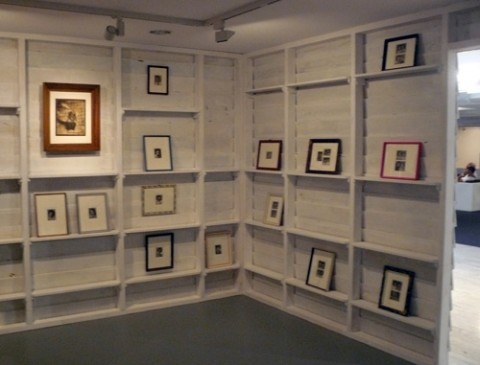
Sooshie Sulaiman (b. 1973, Malaysia), Darkroom (2007-09), Photography, mixed media, timbre; Installation view, Queensland Art Gallery APT6; Photograph by Gina Fairley
Welcome to the second part of the Sixth Asia Pacific Triennial Roundtable. I hope the dialogue here between curator Clarissa “Lisa” Chikiamco (LC), artists Ho Tzu Nyen (HTN), Shooshie Sulaiman (SS) and myself (GF)sparks some throughs and perhaps even a dialogue of your own.
Gina Fairley
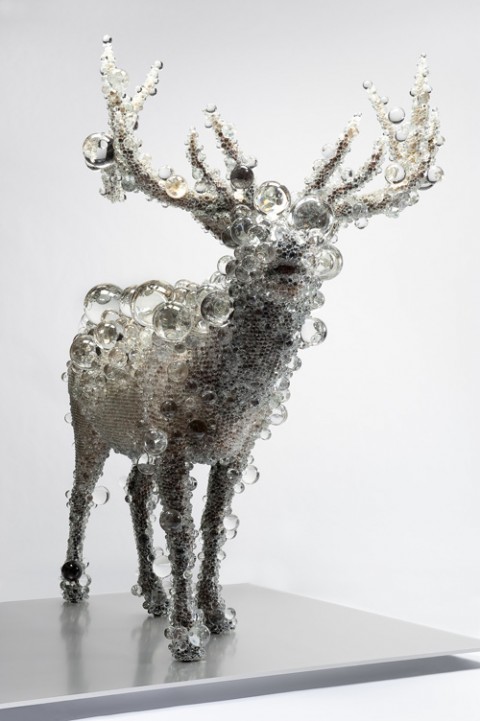
Kohei Nawa (b. 1975, Japan), PixCell – Elk #2 (detail), 2009, Taxidermied silk, glass, acrylic, crystal beads, 240 x 249.5 x 198 cm; Work created with support of Fondation d’enterprise Hermes; Courtesy of the artist and SCAI, Tokyo; Photography by Seiji Toyonaga

Thukral and Tagra (India), Escape For A Dream Land, 2009, Mixed media installation; Project for APT6; Photograph by Gina Fairley
GF: I want to focus on that word ‘dissonance’ that Curatorial Manager Suhanya Raffel uses to describes APT6 in the exhibition’s catalogue. So, if I consult my handy MAC dictionary, dissonance’s primary definition is: a combination of sounds that is unpleasant to listen to; a lack of consistency or compatibility between actions or beliefs. Do you think that was successfully conveyed as an idea in APT6? And do you think dissonance is a good descriptor for this region?
LC: The exhibition’s hang seemingly corresponding to Suhanya’s concept of dissonance – there was a disjointedness between the artworks in my opinion. Without a theme to relate the artworks, it becomes more natural to simply take each artwork for itself, which had been my first reaction in looking at show and reading the individual wall texts. However, I would have liked [introductory] texts in the galleries that would have commented on or elaborated this dissonance that the APT surveys as one of its main purposes.

Kibong Rhee (b. 1957, South Korea), There is no place – Shallow cuts, 2008, Glass, fog machine, artificial leaves, wod, sand, motor, timer, steel; Installation view; Courtesy of the artist and Kukje Gallery, Seoul.
SS: I feel differently. I think the concept of dissonance is quite visibly minor in APT6. When I toured the show for first time with Russell Storer, I could easily associate the flow of hang. Every artwork seemed to have been very carefully placed. It was more like a crafted disturbance – not harsh at all. Maybe contextually one can see the ‘dissonance’, but not so much in the structure of seeing. I compare this with strong dissonance in Aue Pavillion in documenta 12, which challenged me tremendously, and made me curious to ask the curators the reason for their approach. The aesthetic of risk suits these structures. I think we must read big events [like biennales] with our own archive of references and create our own perspective in looking. I consider strongly each exhibition’s roles and history – its position – before I want to make myself understand – my position.

Hiraki Sawa (b. 1977, Japan), O, 2009, 3-channel video projection, 10 short films on monitor, 5 channel sound by Dale Berning on spinning speakers, colour, black and white, 8 minutes; Commissioned for APT 6; Photograph by Gina Fairley
GF: If we are considering, as Shooshie says, our ‘perspective of looking’, then my question is do works get a fair ground for consideration? There was a lot of bling or ‘biennale spectacular ‘on first impression. The quieter works were almost lost. A classic example is Kibong Rhee’s installation of a tree subsumed by a fog environment alluding to ancient scroll painting and Hiraki Sawa’s multi-dimensional study of spinning objects. The pace or balance kind of felt out of wack. For me it was the quieter works that spoke the loudest – such as your work Shooshie. I think it was a very alert and contemporary work. And Jun Nguyen-Hatsushiba film of the Mekong juxtaposed with works by Svay Ken for example, was strong in that it collected dialogues across generations and geography. How do you all feel about the synergy of APT6?
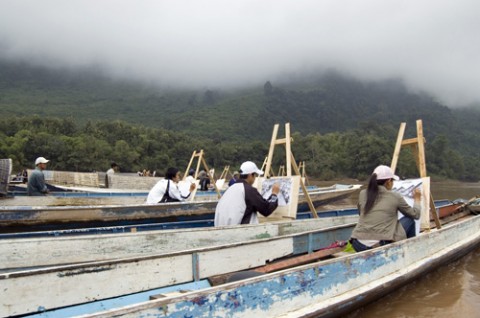
Jun Nguyen-Hatsushiba (b. 1968, Japan/United States/Vietnam), The Ground, the Root, and the Air: The Passing of the Bodhi Tree (still), 2004-07, High definition digital video, single channel, colour sound, 14:30 minutes; Image courtesy of the artist, The Quiet in the Land, Laos, Mizuma Art Gallery, Tokyo and Lehmann Maupin Gallery, New York. Photograph by Yukari Imai
HTN: Gina I wonder if you can clarify the terms ‘biennale bling’ and ‘quiet’. These terms seem to imply some form of dichotomy, while suggesting a kind of implicit ‘moral’ hierarchy where the so-called ‘biennale bling’ are ‘loud’ and thereby almost automatically(?) hollow, while works that seem quiet are somehow assumed to possess some form of superior depth. It seems rather like saying that only the quiet kids in class are good kids, and the loud kids can’t be trusted.
Taking the works by Kibong Rhee and Hiraki Sawa as examples, I guess I can see why you describe these works as quiet because they seem to partake in a kind of aesthetic sensibility that is more meditative. Yet at the same time, I would say that one can also describe both these works as being highly spectacular in the scale and the degree of finish in their presentation. Hiraki Sawa’s work consists of three large projections, a number of smaller flat-screens as well as several amazing spinning speakers all arranged within an extremely large room. It seems to have its own kind of ‘biennale bling’ too! I mean this without any critical judgement as I feel Hiraka Sawa’s work is one of the most interesting in APT6.

Subodh Gupta (b. 1964, India), Installation view APT6, Gallery of Modern Art, Brisbane; Stainless steel and steel structure, brass and copper utensils; Photograph by Gina Fairley
GF: Tzu you give me a belly laugh. I was just baiting you where bling = big spectacular are works that we have become conditions to expect with biennales [a particular definition in itself that the APT, in truth, does not fall entirely comfortably within], and quiet = slower, probing works rather than the initial pow read like a headline. We all take liberties in our descriptions and that is the nature of sharing our own responses.
But yes I agree with you, Hiraki Sawa’s work is an interesting one to discuss, and sadly I think missed by many given its location tucked away in a corner of the second level. It does have all the hallmarks of ‘big exhibition production’. I suppose my reading of it as a quieter work is that it asks time of its viewer to take it in and consider its connections. While a seemingly simple premise, it is a deeply complex and sophisticated work. As you rightly suggest the semantics we overlay through such comments like ‘bling’ and ‘quiet’ – or your own ‘meditative’ – carry all sorts of baggage.

Zhu Weibing (b. 1971, China) and Ji Wenyu (b.1959, China), People holding flowers (detail), 2007, Synthetic polymer paint on resin; velour, steel wire, dacron, loadestone and cotton; 500 pieces: 100 x 18 x 8 cm (each); Collection of Queensland Art Gallery; Photograph by Gina Fairley
SS: It’s a very expected format and Suhanya’s team upgraded more the ‘spectacular’ prestige. The show is huge and beautifully fused… the aura of prestige as ‘bling’ was achieved. After all the body of works by the artists aesthetically were successful in communicating their ‘regional’ message to the audience. However, I also agree with Gina in that I feel ‘the quieter’ pieces do fade away. The institution must create special tools and be more curatorially alert to handling deeper subjects / quieter pieces to allow for their audience’s developments. Placing artworks need guts! I respect APT6s curatorial team in handling hierarchy and ego’s! I like my area under the stairs; it’s perfect for my piece however it is not well planned in terms of audience awareness.

Svay Ken (b. 1933, Cambodia), Leaving the meat and chewing the bones leads one to ruins, from ‘Sharing Knowledge’ series 2008, Oil on canvas, 80 x 100.2 cm; Collection of Queensland Art Gallery
HTN: The question for me is whether the hang of APT is a strong form of dissonance or a limpid take on randomness? Second, if the works are freed from the task of responding to an imposed narrative (and to each other), are they now over-determined by the dictates of gallery design? And if so, what are the implications of this over-determinism by design?
GF: The problem with the APT is that is has to accommodate the scale of GoMA – so it is always going to have that first impression with big showy works. As – I think you are suggesting – such a hierarchical dichotomy of works: big / intimate, spectacular / quiet, brash tangibility / mystical or ethereal – undoubtedly leads to fracture within the curatorial model. To MANAGE that flow between works and scale; the exhibition’s pace between awe and curiosity – and this is not even considering the diverse audience of a major state museum – is a tricky base to work from. One curatorial model it to attempt to stitch it all together with threads, connecting works or themes as Lisa suggested, or the other options is to opt for disconnection as both you Tzu and Suhanya’s comment point towards.
I suppose neither is right or wrong. It is a curatorial choice. As you say Shooshie “Placing works takes guts!” My criticism falls in navigation. How do we-the general public-know which route they -the curators and institution-are taking? As you suggest Tzu, we are given 160 individual capsules for consideration. How do we start to understand this region through these works? These ideas are compounded when you add to that a 16-year history that has conditioned audiences, and arts professionals like ourselves.
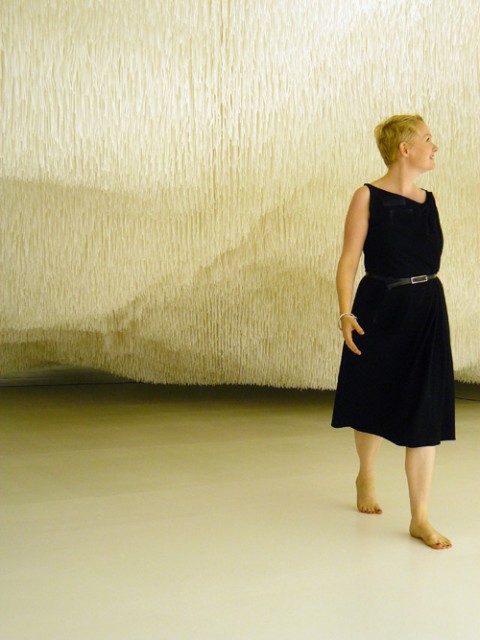
Shinji Ohmaki ((b. 1971, Japan), Liminal Art- Descend, 2007-09, Nylon string, fluorescent light, glass; Installation view APT 6 Gallery of Modern Art, Brisbane; Photograph by Gina Fairley
SS: As an artist, I think the audience needs to learn to be independent at choosing what artwork appeals to them and what they relate to, and not so much rely on curatorial guidelines. They need to use their own ‘archive’ to interpret or understand. But as the mediator (the institution), the job in multi-level interpretation can be really tough especially when most of the audiences are art related. My experience with documenta was that it was the local public who responded and celebrated. I saw an Andy Warhol original silk screen print in a home in Kassel. This lovely family purchased this work at a documenta exhibition in the 70s. To me, this isn’t about the act of purchasing, but how the general public has engaged contemporary art in their everyday lives. Again, this takes us to what kind of relevance are we looking at here with the APT. As young as APT is, it has proven strongly its critical qualities in many aspects. APT6 is really huge and a highlight of this region!
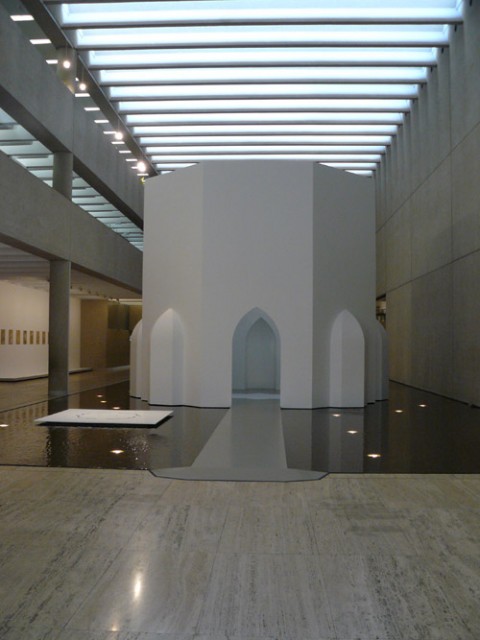
Ayaz Jokhio (b. 1978, Pakistan), a thousand door and windows too…, 2009, MDF, wood, aluminium, paint, 600 x 600 x 600 cm; Site specific work for APT6, installation view Queensland Art Gallery; Photograph by Gina Fairley
LC: I was pretty surprised at how few people there were on the second day and all the empty seats in the symposium after the keynote speaker.
GF: Both of you might be surprised to know that APT5 drew a reported crowd of 700,000 [that is more than half of the events attendance over its 16-year history] and almost 45 per cent of APT5 audience was aged under-35. The largest audience is a local public. As Deputy Director Lynne Seear said to me last year, “…we are very audience focused.”
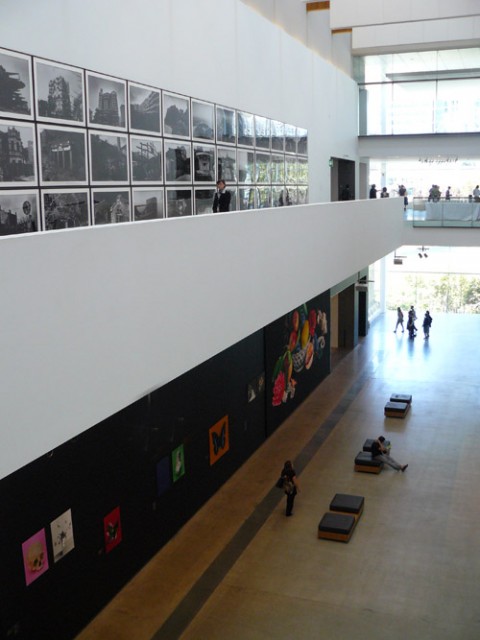
Installation view of APT6, Gallery of Modern Art, Brisbane; Photograph by Gina Fairley
LC: I think the most successful aspect of APT6 would be the kids’ program. They obviously thought and put a lot of time in it. For me it was refreshing to have an art exhibition that put a lot of priority on children as visitors. It was a pleasant surprise to discover that most works had a caption for kids, while it was no surprise at all to see the adults enjoying participating in the kids’ APT commissioned works!

Gonkar Gyatso, Funky Buddhas, 2009, for Kids’ APT activity APT6. Photograph by Katie Bennett; Image courtesy of Queensland Art Gallery
GF: Their focus is clearly underlined in their programming and commissioning of works. How can one challenge or criticise Kids APT – it is brilliant. My grave fear, however, is that by embedding education-driven artwork for kids within the core exhibition it drags down the level of critical inquiry and flow across the exhibition. Just thing the two works you see when you first enter each of the venues are Kids commissioned works – one of which is your’s Tzu “H the Happy Robot”. My critique is not at the work but at the tone it sets for such a sophisticated and layered exhibition from the outset. What is so wrong with containing it to the huge and sensational GoMA education centre and kids didactics?
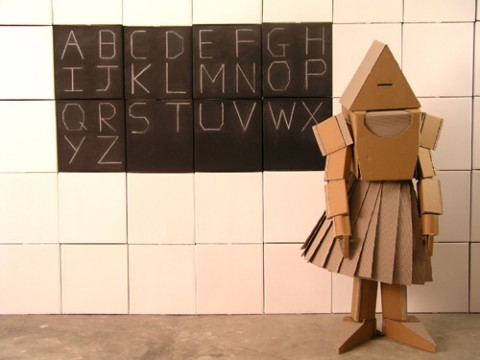
Ho Tzu Nyen (b. 1976, Singapore), H the Happy Robot (production still), 2009, High definition digital video, single channel, colour, sound, 6:42 minutes, ed. of 3; Commissioned for APT6; Supported by the National Arts Council and Singapore Film Commission. Image courtesy of the artist and Tzulogical Films; Photograph by Stephanie Goh
HTZ: Is the design of APT6 driven by functional principles such as ease of access or convenience (for example, works allocated according to respective size) or is it aesthetic (this work looks good next to the other)?
GF: I did another roundtable for the Australian magazine Eyeline with David Teh and Lee Weng Choy. Of concern at the time of our discussion was that the APT had become somewhat ‘GoMAised’. I know I am a little out on a limb but with the level of focus on Kids APT, then add to that is Pacific Reggae section [essentially comprised of music video clips] and then a cinema program, the visual component has become bundled up in this greater ‘Public Program’ – or GoMA brand as the guys were discussing. Perhaps this is the great clash of dissonance?
Finally, in response to Tzu constant probing and questioning for definitions – I just used “bling” in the same way that Shooshie chose “mystical” and Lisa “Asianness” – they are seemingly loaded triggers, yes, but that point of connection for an exhibition this diverse in its scope is going to land differently for everyone. Each is a valid response and in considering them I think it starts to expose the many layers that exist within this exhibition and that have not been fleshed out by the APT.
For me, walking away from APT6, I felt there was a greater sense of disconnection than past editions of the exhibition – albeit curatorial disconnection or one’s own disconnection. While ‘Asia’ is far from consistent or compatible-and I can see the desire to work against the catch cry of ‘contemporary Asian art’-dissonance needn’t work against curatorial synergy.
The question I would like to leave ARTERI readers is: Do you think the APT today has a relevance to the region it profiles?
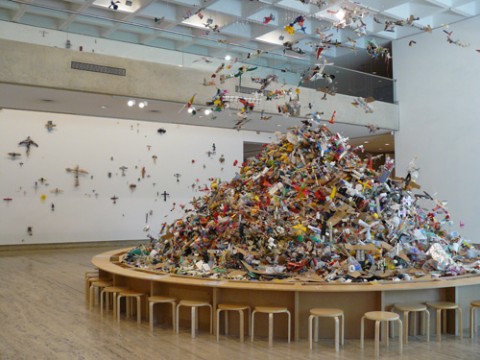
Alfredo and Isabel Aquilizan (the Philippines), In-flight (Project: Another Country), 2009, Mixed media, site specific work for APT; Installation view Queensland Art Gallery; Photograph by Gina Fairley
~
Both the work of Ho Tzu Yuen [Singapore] and Shooshie Sulaiman [Malayisa] was presented in APT6. Clarissa “Lisa” Chikiamco [Philippines] has just completed her MA in Art Curatorship from the University of Melbourne and caught APT6 enroute to returning to the Philippines; and Gina Fairley is a freelance writer specialising in Southeast Asian contemporary art. She was formerly Exhibition Co-ordinator for the Biennale of Sydney.
This roundtable is also published by www.slot.net.au and excerpts in the Philippines. I want to thank all involved for their generous support and candid conversation.
Sorry, the comment form is closed at this time.
The question I would like to leave ARTERI readers is: Do you think the APT today has a relevance to the region it profiles?
Do the regions care? It seems like it almost exist as a one way kinda of dialogue. The APT as a symposium with little regard to how this knowledge and exchange is channeled back into the local communities other than through the participating artists and curators, whose impact and translation of ideas back into the region is often very slow and minimal.
Also due to the scope of the APT, it is quite impossible to provide anything other than a general survey of a particular pocket region with the Asia Pacific and often achieved through the assistance of local curators who tend to pick the familiar names in order to reflect and match the level of contemporaneity within a particular region with the entire world.
So artists tend to be the same, nothing I wouldn’t be able to discover based on a few clicks on the internet since they tend to recycle the same artists over and over again anyway!
Is it time for APT to revise its strategies? Work with grass-root artist/curator or organisers instead of relying on the usual suspects, including well established independent curators? Or maybe should the focus be tighter for the next APT with GOMA curators really doing their fieldwork and slog out in the third world for a change?
It does seem explicitly stated that APT is local public focused, perhaps that is where the two way dialogue goes?
Other than the cataloging of our art for future generations, was APT even meant to be of any significant immediate benefit for the regions that participated?
I think ‘For us here’ seems to be saying that they aren’t doing enough and that the dialogue is heavily tilted one way as a result. I agree with Jess that the immediate benefit is highly unlikely, although I am not sure how archiving the event in the form of a heavy tome would translate to future impact on a scale that can compete with other forms of cultural knowledge/entertainment? In most instances there will be that few privileged curators and artists who will have access to this catalogue and then how? Percolation of new ideas in art into mass consciousness is often said to be a slow process – but with the recent technological speed up thanks to the internet and all, are we also obligated to revise our strategies?
“cataloging of our (Asians?) art for future generations (Austrialians?)”…I wonder if this is similar to the way Americans collected more early modern art than Europeans did. The juiciest European Moderns tend to be in NY, not Paris.
If Asian – Australian ties and public outreach were the main concerns of APT, then more interest should go to cutting edge Asian new media artists, designers, hackers, & programmers – those who have the chops to break spatial boundaries and digital barriers continue to form (I heard strict net censorship laws are forming down under). Live performance artists are cool too. Live streaming video performance art, or Asian-Australian flash mob-ish activities, now how cool would that be? Have these strategies been taken up seriously by APT before?
All the pictures here are mostly metaphorical constructions made from massive accumulations and mixing of stuff with more stuff in big halls. These kind of trickle down discussions and documentation of those stuff….it’s great for collecting and showing off status but they appear to be done mostly in reaction to changes in the world.
Is there anything there which I should look out for in terms of its potential to shape future Asian society? Anything really ‘cutting edge’? Or should I be satisfied that a collection of stuff is ‘asking/provoking questions’ or looks cool? Australian Bower Birds collect stuff into a beautiful pile and only a pea size brain is necessary.
ED.- AS digital barriers continue to form
what about art looking beautiful? aren’t we tired of controversial art all the time?
From the photos and the roundtable, APT looks like something that I want to go visit, that sticker on buddha children thing so kewwwt!!!
I agree with nads about art looking beautiful, in a time when people are so sick of antics and gimmicks by the art world, it is quite commendable that APT is able to be that wonderful balance of contemporary that is accessible enough to draw the public.
Yes, I would love to see more new media, performance, hacker, technology arts events(flash mobs passe la), maybe the show should have been abit edgier la, but do wonder if its a zero sum thing.
edgier = lesser public outreach?
Judging from the images, it seems like there is quite a balance between new media ‘cutting edge’ works as well as traditional sculpture and painting no? Come on guys, a huge ass event like a triennial needs to have the balancing factor… doesn’t need to be polemical for the sake of being ‘cutting edge’ and cool… besides, it would have been terribly boring seeing it in the music. might as well see it at home.
Installations / Great Art is lots and lots of stuff stuffed together / No stuff no contemporary art/ Stuff are beautiful, lots of stuff makes it more beautiful:
Gonkar Gyatso, Funky Buddhas;
Alfredo and Isabel Aquilizan, In-flight;
Shinji Ohmaki, Liminal Art- Descend;
Zhu Weibing and Ji Wenyu, People holding flowers; Subodh Gupta, Installation view APT6;Thukral and Tagra, Escape For A Dream Land;Kohei Nawa, PixCell – Elk #2;Ayaz Jokhio, a thousand door and windows too…
Video/Image + Installations / If it weren’t for the stuff, you could be enjoying this image on youtube/flickr:
Kibong Rhee, There is no place – Shallow cuts; Hiraki Sawa, 0; Jun Nguyen-Hatsushiba, The Ground, the Root, and the Air: The Passing of the Bodhi Tree;
Ho Tzu Nyen, H the Happy Robot; Sooshie Sulaiman, Darkroom.
Are there any computer terminals in the installation views or weblinks of online works?
Let’s face it, most contemporary artists have not had any major effect on society by sticking to old world mediums. They simply pander to the human insecurity of needing stuff to make life meaningful.
Hackers and programmers have revolutionize the world and the art world needs to give the more artistic ones amongst them opportunities to explore ways to harmonize the integration of technology into society and make global communication more fluid. Please check out MIT Media Lab for some of these potentials.
Again, my points are relavent only if public outreach and Oz/Asian ties are really the goals of APT.
If it’s simply to set the style of what looks pretty in my big modern house, I’ll be the first to buy the Buddha sculpture once sweet innocent happy kids have stuck it full with stickers.
@Shingae
bout flash mobs being passe..probably because its been parasited by corporations for marketing purposes.
My interest in seeing more developments into mobs like activities is to ensure that there’s continual improvements on using communication technology to organize and mobilize the population.
Sure, seeing spotaneous formation of swarms to do idiotic things is idiotic but it is also a warning to big brother that the public can be activated into swarms during political crisis or help in humanitarian situations during disasters. To do so, creative people need to be playing with mobile networks, applications, geo tagging/mapping etc…
Instead, the artists seem to prefer spending endless hours indoors putting stuff together like factory workers high on drugs
Dick, I do agree with you on Art not catching up on technology, but that’s more like a criticism towards the whole industry rather than just APT.
For one, australian-asian ties do not have much significant internet-ish, cyber/tech relationship, unlike say tibet/USA or China/rest of the world, or even Iran’s twitter/election thing(okay, Burma had sort of something).
A focus on tech inclined art to redefine the whole powerplay of lord/minion in this event and region would seem a bit forced.
The australian-asian relationship has been defined much by physical migration though, flashmob/boatpeople anyone?
All these discussions and the whole event makes me feel like APT is an exhibition of “hey, lookit what our third world neighbours are capable of” and the whole cataloging seems like “they dont know whats good for us so lets save them from themselves”
but all nicely rounded up by Gina’s conclusion of “hey man, we are all different, but is okay, we’re all still Asians”
Thanks guys for all considered comments. Given the interest in the tech side of the exhibition expressed – I picked up the catalogue again just to check how much shown really had a tech component. It didn’t come up in our conversation – except for the mention of Ho Tzu Nyen’s happy robot for KIDS ATP, Moffatt’s OTHER, Hiraki Sawa’s three projections amidst his spinning objects, and Jun Hguyen-Hatsushiba’s single channel project for the Mekong Project. Counting up there were 13 artists who presented works either as large scale projects, intimate flat screen DVDs or animation pieces – with several of the artists presenting multiple works such as the New Zealand artist Campbell Paterson who had a suite of 10 digital videos of everyday studies – like how long he could hold his mum before dropping her or eating chips at burger king and spitting them out to create ‘chip mountain’.
I should mention that Tzu did a major film project working with the students of La Salle which was screened at cinematic proportions; the largest work using technology was Qiu Anxiong’s huge three-screen animation on the demise of the world; Turkish artist Emre Huner also tackled this topic in his animation “Panoptikon”, and there was an emphasis placed on Iranian Animation with I think with the work of 6 different artists screened. And the Indian artists Thukral and Tagra screened YouTube on a TV set within their lounge room environment – so these conversations about medium are relevant. Thinking about this I will still with my earlier comments that the flow of these were inconsistent. It is always hard to ‘insert’ work of this nature and demand the viewers time to sit down for 20 minutes. These are interesting questions not only for the curator but the artist making the work. I have sent some images to the ARTERI crew that they can hopefully add to this conversation for you to check out the other works. Again thanks to all for your comments.
I need to add a correction – and it goes to show how long I stopped at the Iranian Animation section of APT6 – I said there were about 6 artists screened. I just counted up the exhibition list and there were 60!
So lots of content in this medium and one would have to say a thorough investigation – however how many skipped over it like me? It was placed in the first main gallery in the axis corridor between all those big spectacular works by Subodh Gupta, Kohei Nawa’s elk, Thukral and Tagra, Rudi Manofani’s guitars, and then the big mirror mural by Monir Farmanfarmaian. Was that really the right place to stop and contemplate?
Thanks for the update Gina but would you consider them to be under the category of:
Video/Image + Installations / If it weren’t for the stuff, you could be enjoying this image on youtube/flickr
Which of these new media pieces did you enjoy?Why?
Anything really interactive or online? Like stuff which people (well, global middle class atleast) can access everyday? I’d prefer to see more art that seeks a place in common life instead of making a big splash in non accessible places.
It would also make sense to share these works online given the problem you mentioned concerning time. It’s nice offering readers pictures of the screenings but its again a kind of trickle down high culture I find totally powerless against the latest internet memes
http://www.dipity.com/tatercakes/Internet_Memes
:P
Ello Dick, I think you’re being terribly unfair to say that museums are non accessible spaces for the middle class , especially the local middle class, in countries where contemporary art is part and parcel of their popular culture. Museum attendance is very different in the West as you know very well and these spaces are in many ways interactive and social spaces too. We can’t always apply the irrelevance of museums/galleries in countries such as ours (i.e. Malaysia) to other countries. This is my humble opinion la… I’m sure we all agree that the role institution plays in different country vary and it’s more complex than saying museums are dead and irrelevant spaces even though I’m more than guilty of declaiming that all the time :P
On another note, just wanna point everyone to this article that’s written on the idea of Asian-ness…
http://www.c-artsmag.com/articles/detail.php?Title=What%20exactly%20is%20“Asian”%20about%20Asian%20Art?%20The%206th%20Asian%20Pacific%20Triennial%20and%20the%204th%20Fukuoka%20Asian%20Art%20Triennal&articleID=113
Some interesting points about the topics, methods and themes that surface in Asian art that most Western practices wouldn’t be able to get away with… although what does that address in terms of our regional identity is anyone’s guess! I still can’t quite connect the middle east as part of the Asian cultural sphere for instance :)
Um i just meant that as impressive as a picture of an artwork in Australia or earthquake in Chille may be, its impact on my daily life is very minimal compared to the way mobile phones, computers, and the internetz.I’m just asking why can’t there be more high/powerful art made for the devices which are considered indispensable to our daily lives?
The impression from I get from this API piece is that contemporary asian artists have little to say about new media beyond video, and great art will always be something you have to go to (if you are a wealthier country, it’ll come to you). Even if a museum was right around the corner, I would still like to see what the brightest and most creative members of the region could do with technology that breaks down traditional notions of space and time, hence it relavance to ‘Asianess’. How do you maintain local identity such conditions? Instead of just having news about art showing up on FB, why not use FB as a medium/surface for art?
Uploading your photography and poetry is one thing but the juicy bit is when you begin to hack/appropriate its mechanism/ applications. Primative examples are those who are using the tagging mechanism in the photo section with cartoon characters, or when profile photos are changed to show solidarity for a cause. In both cases, collaboration and interaction is involved but most artist still see themselves as the star and the viewer as passive observers of their masterpiece, thus what I’ve seen only has the quality of folk art. I’m waiting for something more gripping which can manipulate monsters such as Twitter/Facebook in ways its American corporate owners could never imagine the world could do. I’m not sure that will happen when tech related work means showing someone dressed as a cardboard robot.
Thanks again for the level of commentary – really appreciate the thoughts and yes they probe me into thinking further on this point. I have to preface this by saying my area is not digital medium so I speak only as any other.
What did I enjoy? I have to say I prefer Qiu Anxiong’s epic three-channel animations over Campbell Patterson one-liners. Is that merely an old fashion search for meaning? Is it a more sensual response to space and the act of engagement? On the same note I have to say I sat – at two occassion – entire through Hiraki Sawa’s spinning objects sound and video installation, yet I could not sit through Tzu’s film piece. And Jun’s Mekong film was widely enjoyed – I saw it also in Guangzhou and it had the same resonnance with audiences – so perhaps we are not yet willing to let the narrative go?
Re-reading your words – the interactive component to APT6 was pretty focused on APT6 and live feed only semi addressed with T&T the indian duo. I have to respond like Simon however to the middle class catch-cry – my immediate ‘ping’ of consideration is youtube – it would have to be the most dynamic dissemination of medium produced using video and internet technology that sits right on that ‘common denominator’ across social class and geography. Video is a sophisticated middle class medium one could argue from the point of view of mere economics of the equipment and yet it is available to all. For example anyone can post and circulate a contemporary video ‘art’ piece and announce and like thru facebook; you can find amazing lectures re-broadcast from the 60s with artists such as Rauschenberg in conversation with Castelli; or you can see it entering a work like T&Ts loungeroom in APT6 where they streamed youtube homemade bollywood karoke. The high and low collide and at each end we begin to consider the ‘possibilities’ that exist beyond our own worlds.
Campbell Patterson in APT6 uses the genre of youtube – really banal one liners quickly delivered – but delivers them using HD and within a contemporary art dialogue – again high and low collide.
I just came across this week the launch of a project in the Philippines called ARTiculation that will upload 10 profiles on contemporary Filipino artists over the year using you tube as their feed. This is where it starts to get really interesting is when artists working today can hijack available modes of dissemination to expand the way we respond to digital media in its various forms. There is a festival held in Melbourne later this year worth checking out NEXT WAVE.
Again this is not my area so I beg a little ignorance but as one sifting through the deluge of medium I find it terribly exciting and a pace that is constantly breaking down the kind of divisions that you suggest. I would like to suppose that the next 5-year period we will see a lot more of this kind of ‘live / interactive’ artworks you suggest in our region – just look at how contemporary photography has tracked to the forefront in recent years. It is merely shifting perceptions and that is exciting and vital territory.
Best G
great post thanks very much